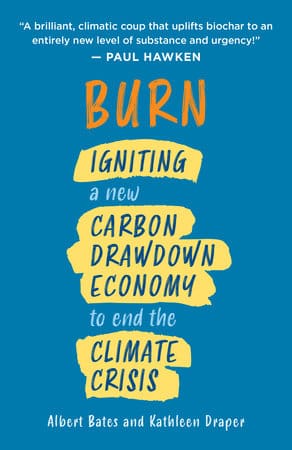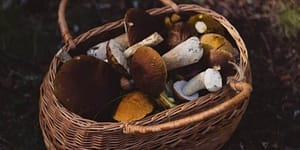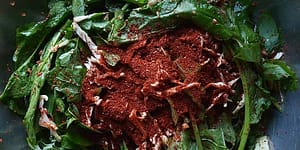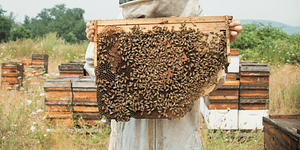How to Make Biochar
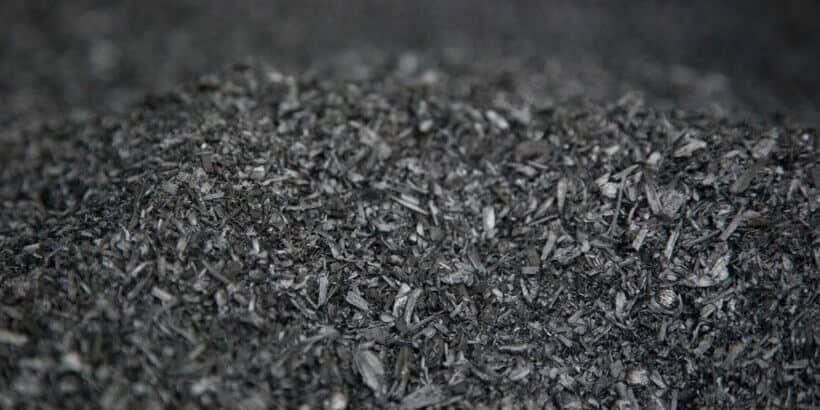
For something that looks like a lump of charcoal, biochar certainly has a great press agent. The subject of books, articles, blog posts, research papers, workshop presentations, conference talks, and various top-ten-ideas-that-will-change-the-world lists. Its potential ability to address a variety of global challenges is indisputably large. So, how exactly do you make this strange material?
The following excerpt is from Burn by Albert Bates & Kathleen Draper. It has been adapted for the web.
Making Biochar
This book describes many of the identities assumed by carbon but we linger most often upon what is now being referred to as biochar, a hard, almost crystalline form that persists long after most photosynthetic carbon has decayed away. Biochar may be added to soils with the intention to improve soil functions and to reduce emissions from biomass otherwise naturally degrading into greenhouse gases. Its formidable carbon sequestration properties can be measured and verified in a characterization scheme, or in a carbon emission offset protocol.
The term biochar appears more than seven hundred times in this book, although it only came into use at the end of the twentieth century after the discovery of charcoal-enhanced soils created by indigenous cultures dating back thousands of years. Scanning the research literature on biochar, now growing exponentially, it is clear the term has gone well beyond its original intent. It’s conventional wisdom in the biochar community that not all biochar is the same and not all char is biochar. Rather than attempting to standardize it, “fit for purpose” is the latest way of classifying different types of biochar.

The best charcoal was made at low temperatures. Fuel wood—often oak, hickory, ash, or maple—was generally stacked in piles and covered with damp earth, lit from the top of the pile, and left to combust and smolder for days. Burning wood slowly and at low temperatures is still one of the least expensive and easiest ways to make charcoal.
Biochar can be made from a much broader range of materials than charcoal can. Crop residues, manures, and wood are all potential feedstocks. In addition to use in the soil, newer uses for biochar are now competing with traditional uses for activated carbon, carbon black, and graphite. It is also well poised to displace, at least in part, noncarbon materials such as sand, Styrofoam, and fiberglass.
Tweaking the production parameters and the feedstock can result in widely divergent characteristics that allow biochars to be optimized or designed for specific uses. Perhaps the most defining characteristic of biochar versus many of its other carbon cousins is its planetary impact.
Unlike charcoal made from dwindling forests or activated carbon made from fossil fuels, biochar can have a tremendously positive effect on the planet both in reversing climate change and in providing products and services the world needs.
The specific thermal modification that converts biomass into biochar can be viewed from two closely related processes: pyrolysis and carbonization.
Pyrolysis relates to the chemical breakdowns that result in the liberation of pyrolytic gases. Carbonization is what comes next: the chemical buildup of the carbon atoms into solid structures. The bulk of pyrolysis and carbonization reactions occur in the temperature range from about 320°C to 800°C (608°F to 1472°F). One can think of pyrolysis and carbonization as simultaneous physical–chemical processes, changing the biomass into pyrolytic gases and charcoal.
We have occasionally found sources for perfectly good biochar already pyrolyzed and ready to micronize, moisten, mineralize, and microbialize. One biochar researcher we know uses her old aquarium filter charcoal to grow amazing tropical plants in pots.
In rural Tennessee we have managed to arrange delivery of truckloads of filtration char from distillers like Jack Daniels and George Dickel (produced in the town of Cascade Hollow). Of course, the whiskey residues, which are antifungal and antibacterial, can pose a problem for the compost pile or microbial inoculation, so we generally season this product outdoors and let rain denature the spirits.
When we first learned about biochar, we were convinced its ability to sequester carbon would make people sit up and take notice. That hasn’t happened yet for many different reasons. Later, we thought that its ability to improve yield and soil fertility was really what was going to cause people to sit up and take notice.
That hasn’t happened either.
Both of those ideas might still be approaching some kind of inflection point, but when or how the great turning might happen remains a mystery. Maybe if regulatory changes occur in carbon markets or if food security continues to be challenged by climate change, that will force a paradigm shift to regenerative agriculture. Or maybe there is something else that could drive such a change.
Recommended Reads
Recent Articles
Beavers are ecological and hydrological Swiss Army knives. Capable of tackling just about any landscape-scale problem you might confront.
Read MoreWhen you’re walking around the grocery store looking at the vegetables, it’s probably hard to imagine that a century ago there was twice the amount of options.
Read MoreFor people who enjoy foraging for food in the wild, there are plenty of mushrooms to choose from — “ten thousand mushroom species to be considered on the North American continent alone”. But foraging for mushrooms should never be thought of as a game of chance. You need to know all the clues when it comes to identifying…
Read MoreNeed a new twist on kimchi? Look no further than this wild green kimchi! Experiment with what you have, anything from the mustard family will work extremely well.
Read MoreFor all the beekeepers and future beekeepers out there, this one is for you! Your journey to successful beekeeping begins with constructing a suitable haven for honeybees, otherwise known as the bee hive. The following is an excerpt from Raising Resilient Bees by Eric and Joy McEwen. It has been adapted for the web. Bees…
Read More
